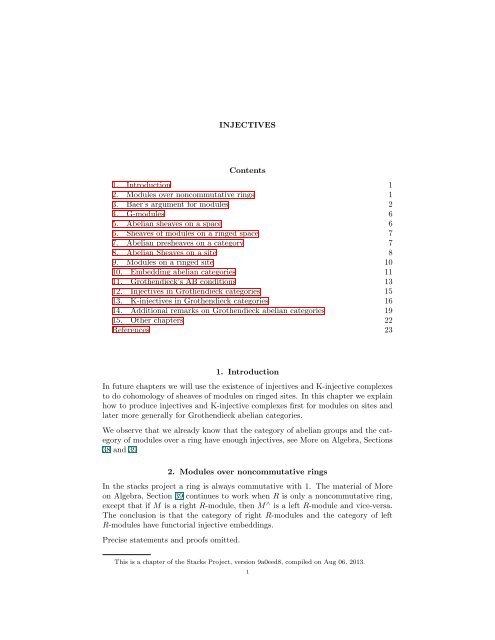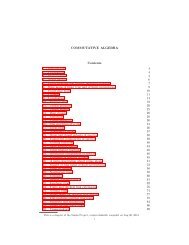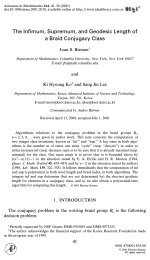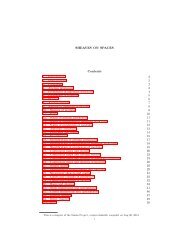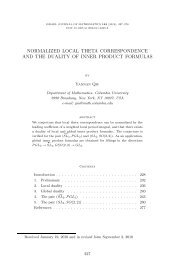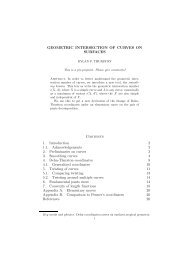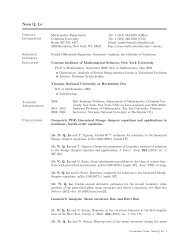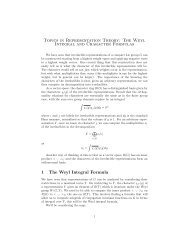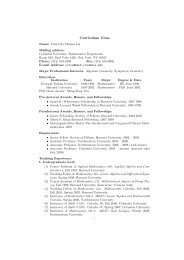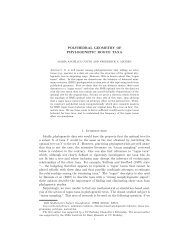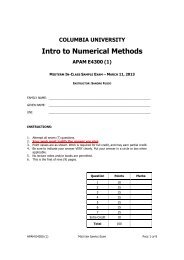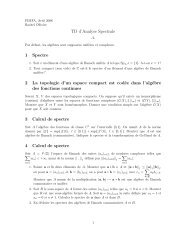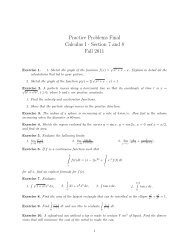INJECTIVES Contents 1. Introduction 1 2. Modules ... - Stacks Project
INJECTIVES Contents 1. Introduction 1 2. Modules ... - Stacks Project
INJECTIVES Contents 1. Introduction 1 2. Modules ... - Stacks Project
Create successful ePaper yourself
Turn your PDF publications into a flip-book with our unique Google optimized e-Paper software.
<strong>INJECTIVES</strong><br />
<strong>Contents</strong><br />
<strong>1.</strong> <strong>Introduction</strong> 1<br />
<strong>2.</strong> <strong>Modules</strong> over noncommutative rings 1<br />
3. Baer’s argument for modules 2<br />
4. G-modules 6<br />
5. Abelian sheaves on a space 6<br />
6. Sheaves of modules on a ringed space 7<br />
7. Abelian presheaves on a category 7<br />
8. Abelian Sheaves on a site 8<br />
9. <strong>Modules</strong> on a ringed site 10<br />
10. Embedding abelian categories 11<br />
1<strong>1.</strong> Grothendieck’s AB conditions 13<br />
1<strong>2.</strong> Injectives in Grothendieck categories 15<br />
13. K-injectives in Grothendieck categories 16<br />
14. Additional remarks on Grothendieck abelian categories 19<br />
15. Other chapters 22<br />
References 23<br />
<strong>1.</strong> <strong>Introduction</strong><br />
In future chapters we will use the existence of injectives and K-injective complexes<br />
to do cohomology of sheaves of modules on ringed sites. In this chapter we explain<br />
how to produce injectives and K-injective complexes first for modules on sites and<br />
later more generally for Grothendieck abelian categories.<br />
We observe that we already know that the category of abelian groups and the category<br />
of modules over a ring have enough injectives, see More on Algebra, Sections<br />
38 and 39<br />
<strong>2.</strong> <strong>Modules</strong> over noncommutative rings<br />
In the stacks project a ring is always commutative with <strong>1.</strong> The material of More<br />
on Algebra, Section 39 continues to work when R is only a noncommutative ring,<br />
except that if M is a right R-module, then M ∧ is a left R-module and vice-versa.<br />
The conclusion is that the category of right R-modules and the category of left<br />
R-modules have functorial injective embeddings.<br />
Precise statements and proofs omitted.<br />
This is a chapter of the <strong>Stacks</strong> <strong>Project</strong>, version 9a0eed8, compiled on Aug 06, 2013.<br />
1
2 <strong>INJECTIVES</strong><br />
3. Baer’s argument for modules<br />
There is another, more set-theoretic approach to showing that any R-module M can<br />
be imbedded in an injective module. This approach constructs the injective module<br />
by a transfinite colimit of push-outs. While this method is somewhat abstract and<br />
more complicated than the one of More on Algebra, Section 39, it is also more<br />
general. Apparently this method originates with Baer, and was revisited by Cartan<br />
and Eilenberg in [CE56] and by Grothendieck in [Gro57]. There Grothendieck uses<br />
it to show that many other abelian categories have enough injectives. We will get<br />
back to the general case later (insert future reference here).<br />
We begin with a few set theoretic remarks. Let {Bβ}β∈α be an inductive system<br />
of objects in some category C, indexed by an ordinal α. Assume that colimβ∈α Bβ<br />
exists in C. If A is an object of C, then there is a natural map<br />
(3.0.1) colimβ∈α MorC(A, Bβ) −→ MorC(A, colimβ∈α Bβ).<br />
because if one is given a map A → Bβ for some β, one naturally gets a map from A<br />
into the colimit by composing with Bβ → colimβ∈α Bα. Note that the left colimit<br />
is one of sets! In general, (3.0.1) is neither injective or surjective.<br />
Example 3.<strong>1.</strong> Consider the category of sets. Let A = N and Bn = {1, . . . , n}<br />
be the inductive system indexed by the natural numbers where Bn → Bm for<br />
n ≤ m is the obvious map. Then colim Bn = N, so there is a map A → lim Bn,<br />
−→<br />
which does not factor as A → Bm for any m. Consequently, colim Mor(A, Bn) →<br />
Mor(A, colim Bn) is not surjective.<br />
Example 3.<strong>2.</strong> Next we give an example where the map fails to be injective. Let<br />
Bn = N/{1, 2, . . . , n}, that is, the quotient set of N with the first n elements<br />
collapsed to one element. There are natural maps Bn → Bm for n ≤ m, so the<br />
{Bn} form a system of sets over N. It is easy to see that colim Bn = {∗}: it is the<br />
one-point set. So it follows that Mor(A, colim Bn) is a one-element set for every<br />
set A. However, colim Mor(A, Bn) is not a one-element set. Consider the family<br />
of maps A → Bn which are just the natural projections N → N/{1, 2, . . . , n} and<br />
the family of maps A → Bn which map the whole of A to the class of <strong>1.</strong> These two<br />
families of maps are distinct at each step and thus are distinct in colim Mor(A, Bn),<br />
but they induce the same map A → colim Bn.<br />
Nonetheless, if we map out of a finite set then (3.0.1) is an isomorphism always.<br />
Lemma 3.3. Suppose that, in (3.0.1), C is the category of sets and A is a finite<br />
set, then the map is a bijection.<br />
Proof. Let f : A → colim Bβ. The range of f is finite, containing say elements<br />
c1, . . . , cr ∈ colim Bβ. These all come from some elements in Bβ for β ∈ α large<br />
by definition of the colimit. Thus we can define f : A → Bβ lifting f at a finite<br />
stage. This proves that (3.0.1) is surjective. Next, suppose two maps f : A →<br />
Bγ, f ′ : A → Bγ ′ define the same map A → colim Bβ. Then each of the finitely<br />
many elements of A gets sent to the same point in the colimit. By definition of the<br />
colimit for sets, there is β ≥ γ, γ ′ such that the finitely many elements of A get sent<br />
to the same points in Bβ under f and f ′ . This proves that (3.0.1) is injective. <br />
The most interesting case of the lemma is when α = ω, i.e., when the system<br />
{Bβ} is a system {Bn}n∈N over the natural numbers as in Examples 3.1 and 3.<strong>2.</strong>
<strong>INJECTIVES</strong> 3<br />
The essential idea is that A is “small” relative to the long chain of compositions<br />
B1 → B2 → . . . , so that it has to factor through a finite step. A more general<br />
version of this lemma can be found in Sets, Lemma 7.<strong>1.</strong> Next, we generalize this<br />
to the category of modules.<br />
Definition 3.4. Let C be a category, let I ⊂ Arrow(C), and let α be an ordinal. An<br />
object A of C is said to be α-small with respect to I if whenever {Bβ} is a system<br />
over α with transition maps in I, then the map (3.0.1) is an isomorphism.<br />
In the rest of this section we shall restrict ourselves to the category of R-modules<br />
for a fixed commutative ring R. We shall also take I to be the collection of injective<br />
maps, i.e., the monomorphisms in the category of modules over R. In this case, for<br />
any system {Bβ} as in the definition each of the maps<br />
Bβ → colimβ∈α Bβ<br />
is an injection. It follows that the map (3.0.1) is an injection. We can in fact<br />
interpret the Bβ’s as submodules of the module B = colimβ∈α Bβ, and then we<br />
have B = <br />
β∈α Bβ. This is not an abuse of notation if we identify Bα with the<br />
image in the colimit. We now want to show that modules are always small for<br />
“large” ordinals α.<br />
Proposition 3.5. Let R be a ring. Let M be an R-module. Let κ the cardinality<br />
of the set of submodules of M. If α is an ordinal whose cofinality is bigger than κ,<br />
then M is α-small with respect to injections.<br />
Proof. The proof is straightforward, but let us first think about a special case. If<br />
M is finite, then the claim is that for any inductive system {Bβ} with injections<br />
between them, parametrized by a limit ordinal, any map M → colim Bβ factors<br />
through one of the Bβ. And this we proved in Lemma 3.3.<br />
Now we start the proof in the general case. We need only show that the map<br />
(3.0.1) is a surjection. Let f : M → colim Bβ be a map. Consider the subobjects<br />
{f −1 (Bβ)} of M, where Bβ is considered as a subobject of the colimit B = <br />
β Bβ.<br />
If one of these, say f −1 (Bβ), fills M, then the map factors through Bβ.<br />
So suppose to the contrary that all of the f −1 (Bβ) were proper subobjects of M.<br />
However, we know that<br />
<br />
−1<br />
f (Bβ) = f −1 <br />
Bβ = M.<br />
Now there are at most κ different subobjects of M that occur among the f −1 (Bα),<br />
by hypothesis. Thus we can find a subset S ⊂ α of cardinality at most κ such that<br />
as β ′ ranges over S, the f −1 (Bβ ′) range over all the f −1 (Bα).<br />
However, S has an upper bound α < α as α has cofinality bigger than κ. In<br />
particular, all the f −1 (Bβ ′), β′ ∈ S are contained in f −1 (Bα). It follows that<br />
f −1 (Bα) = M. In particular, the map f factors through Bα. <br />
From this lemma we will be able to deduce the existence of lots of injectives. Let<br />
us recall the criterion of Baer.
4 <strong>INJECTIVES</strong><br />
Lemma 3.6. Let R be a ring. An R-module Q is injective if and only if in every<br />
commutative diagram<br />
a <br />
<br />
Q<br />
<br />
R<br />
for a ⊂ R an ideal, the dotted arrow exists.<br />
Proof. Assume Q satisfies the assumption of the lemma. Let M ⊂ N be Rmodules,<br />
and let ϕ : M → Q be an R-module map. Arguing as in the proof of<br />
More on Algebra, Lemma 38.1 we see that it suffices to prove that if M = N, then<br />
we can find an R-module M ′ , M ⊂ M ′ ⊂ N such that (a) the inclusion M ⊂ M ′<br />
is strict, and (b) ϕ can be extended to M ′ . To find M ′ , let x ∈ N, x ∈ M. Let<br />
ψ : R → N, r ↦→ rx. Set a = ψ −1 (M). By assumption the morphism<br />
a ψ −→ M ϕ −→ Q<br />
can be extended to a morphism ϕ ′ : R → Q. Note that ϕ ′ annihilates the kernel of<br />
ψ (as this is true for ϕ). Thus ϕ ′ gives rise to a morphism ϕ ′′ : Im(ψ) → Q which<br />
agrees with ϕ on the intersection M ∩ Im(ψ) by construction. Thus ϕ and ϕ ′′ glue<br />
to give an extension of ϕ to the strictly bigger module M ′ = F + Im(ψ). <br />
If M is an R-module, then in general we may have a semi-complete diagram as in<br />
Lemma 3.6. In it, we can form the push-out<br />
a<br />
<br />
R<br />
<br />
Q<br />
<br />
<br />
R ⊕a Q.<br />
Here the vertical map is injective, and the diagram commutes. The point is that<br />
we can extend a → Q to R if we extend Q to the larger module R ⊕a Q.<br />
The key point of Baer’s argument is to repeat this procedure transfinitely many<br />
times. To do this we first define, given an R-module M the following (huge) pushout<br />
<br />
a ϕ∈HomR(a,M) a <br />
M<br />
(3.6.1)<br />
<br />
a ϕ∈HomR(a,M) R<br />
<br />
<br />
M(M).<br />
Here the top horizontal arrow maps the element a ∈ a in the summand corresponding<br />
to ϕ to the element ϕ(a) ∈ M. The left vertical arrow maps a ∈ a in the<br />
summand corresponding to ϕ simply to the element a ∈ R in the summand corresponding<br />
to ϕ. The fundamental properties of this construction are formulated in<br />
the following lemma.<br />
Lemma 3.7. Let R be a ring.<br />
(1) The construction M ↦→ (M → M(M)) is functorial in M.<br />
(2) The map M → M(M) is injective.
<strong>INJECTIVES</strong> 5<br />
(3) For any ideal a and any R-module map ϕ : a → M there is an R-module<br />
map ϕ ′ : R → M(M) such that<br />
commutes.<br />
a<br />
<br />
R<br />
ϕ<br />
ϕ ′<br />
<br />
M<br />
<br />
<br />
M(M)<br />
Proof. Parts (2) and (3) are immediate from the construction. To see (1), let<br />
χ : M → N be an R-module map. We claim there exists a canonical commutative<br />
diagram<br />
<br />
a ϕ∈HomR(a,M) a<br />
<br />
<br />
<br />
a ϕ∈HomR(a,M) R<br />
<br />
M<br />
<br />
a<br />
<br />
<br />
a<br />
χ<br />
<br />
ψ∈HomR(a,N) a<br />
<br />
<br />
ψ∈HomR(a,N) R<br />
which induces the desired map M(M) → M(N). The middle east-south-east arrow<br />
maps the summand a corresponding to ϕ via ida to the summand a corresponding<br />
to ψ = χ ◦ ϕ. Similarly for the lower east-south-east arrow. Details omitted. <br />
The idea will now be to apply the functor M a transfinite number of times. We<br />
define for each ordinal α a functor Mα on the category of R-modules, together<br />
with a natural injection N → Mα(N). We do this by transfinite induction. First,<br />
M1 = M is the functor defined above. Now, suppose given an ordinal α, and<br />
suppose Mα ′ is defined for α′ < α. If α has an immediate predecessor α, we let<br />
If not, i.e., if α is a limit ordinal, we let<br />
Mα = M ◦ Mα.<br />
Mα(N) = colimα ′
6 <strong>INJECTIVES</strong><br />
This means in particular that there is some β ′ < α such that f factors through the<br />
submodule Mβ ′(N), as<br />
f : a → Mβ ′(N) → Mα(N).<br />
However, by the fundamental property of the functor M, see Lemma 3.7 part (3),<br />
we know that the map a → Mβ ′(N) can be extended to<br />
R → M(Mβ ′(N)) = Mβ ′ +1(N),<br />
and the last object imbeds in Mα(N) (as β ′ + 1 < α since α is a limit ordinal). In<br />
particular, f can be extended to Mα(N). <br />
4. G-modules<br />
Lemma 4.<strong>1.</strong> Let G be a topological group. The category ModG of discrete Gmodules,<br />
see Étale Cohomology, Definition 57.1 has functorial injective hulls.<br />
Proof. By Section 2 the category Mod Z[G] has functorial injective embeddings.<br />
Consider the forgetful functor v : ModG → Mod Z[G]. This functor is fully faithful,<br />
transforms injective maps into injective maps and has a right adjoint, namely<br />
u : M ↦→ u(M) = {x ∈ M | stabilizer of x is open}<br />
Since it is true that v(M) = 0 ⇒ M = 0 we conclude by Homology, Lemma<br />
2<strong>2.</strong>5. <br />
5. Abelian sheaves on a space<br />
Lemma 5.<strong>1.</strong> Let X be a topological space. The category of abelian sheaves on X<br />
has enough injectives. In fact it has functorial injective embeddings.<br />
Proof. For an abelian group A we denote j : A → J(A) the functorial injective<br />
embedding constructed in More on Algebra, Section 39. Let F be an abelian sheaf<br />
on X. By Sheaves, Example 7.5 the assignment<br />
I : U ↦→ I(U) = <br />
x∈U J(Fx)<br />
is an abelian sheaf. There is a canonical map F → I given by mapping s ∈ F(U)<br />
to <br />
x∈U j(sx) where sx ∈ Fx denotes the germ of s at x. This map is injective, see<br />
Sheaves, Lemma 1<strong>1.</strong>1 for example.<br />
It remains to prove the following: Given a rule x ↦→ Ix which assigns to each point<br />
x ∈ X an injective abelian group the sheaf I : U ↦→ <br />
x∈U Ix is injective. Note that<br />
I = <br />
x∈X ix,∗Ix<br />
is the product of the skyscraper sheaves ix,∗Ix (see Sheaves, Section 27 for notation.)<br />
We have<br />
MorAb(Fx, Ix) = Mor Ab(X)(F, ix,∗Ix).<br />
see Sheaves, Lemma 27.3. Hence it is clear that each ix,∗Ix is injective. Hence the<br />
injectivity of I follows from Homology, Lemma 20.3.
<strong>INJECTIVES</strong> 7<br />
6. Sheaves of modules on a ringed space<br />
Lemma 6.<strong>1.</strong> Let (X, OX) be a ringed space, see Sheaves, Section 25. The category<br />
of sheaves of OX-modules on X has enough injectives. In fact it has functorial<br />
injective embeddings.<br />
Proof. For any ring R and any R-module M we denote j : M → JR(M) the<br />
functorial injective embedding constructed in More on Algebra, Section 39. Let F<br />
be a sheaf of OX-modules on X. By Sheaves, Examples 7.5 and 15.6 the assignment<br />
I : U ↦→ I(U) = <br />
JOX,x (Fx)<br />
is an abelian sheaf. There is a canonical map F → I given by mapping s ∈ F(U)<br />
to <br />
x∈U j(sx) where sx ∈ Fx denotes the germ of s at x. This map is injective, see<br />
Sheaves, Lemma 1<strong>1.</strong>1 for example.<br />
It remains to prove the following: Given a rule x ↦→ Ix which assigns to each point<br />
x ∈ X an injective OX,x-module the sheaf I : U ↦→ <br />
x∈U Ix is injective. Note that<br />
I = <br />
x∈X ix,∗Ix<br />
is the product of the skyscraper sheaves ix,∗Ix (see Sheaves, Section 27 for notation.)<br />
We have<br />
HomOX,x (Fx, Ix) = HomOX (F, ix,∗Ix).<br />
see Sheaves, Lemma 27.3. Hence it is clear that each ix,∗Ix is an injective OXmodule<br />
(see Homology, Lemma 2<strong>2.</strong>1 or argue directly). Hence the injectivity of I<br />
follows from Homology, Lemma 20.3. <br />
x∈U<br />
7. Abelian presheaves on a category<br />
Let C be a category. Recall that this means that Ob(C) is a set. On the one hand,<br />
consider abelian presheaves on C, see Sites, Section <strong>2.</strong> On the other hand, consider<br />
families of abelian groups indexed by elements of Ob(C); in other words presheaves<br />
on the discrete category with underlying set of objects Ob(C). Let us denote this<br />
discrete category simply Ob(C). There is a natural functor<br />
i : Ob(C) −→ C<br />
and hence there is a natural restriction or forgetful functor<br />
v = i p : PAb(C) −→ PAb(Ob(C))<br />
compare Sites, Section 5. We will denote presheaves on C by B and presheaves on<br />
Ob(C) by A.<br />
There are also two functors, namely ip and pi which assign an abelian presheaf on<br />
C to an abelian presheaf on Ob(C), see Sites, Sections 5 and 18. Here we will use<br />
u = pi which is defined (in the case at hand) as follows:<br />
uA(U) = <br />
U ′ →U A(U ′ ).<br />
So an element is a family (aφ)φ with φ ranging through all morphisms in C with<br />
target U. The restriction map on uA corresponding to g : V → U maps our element<br />
(aφ)φ to the element (ag◦ψ)ψ.
8 <strong>INJECTIVES</strong><br />
There is a canonical surjective map vuA → A and a canonical injective map B →<br />
uvB. We leave it to the reader to show that<br />
Mor PAb(Ob(C))(B, uA) = Mor PAb(C)(vB, A).<br />
in this simple case; the general case is in Sites, Section 5. Thus the pair (u, v) is an<br />
example of a pair of adjoint functors, see Categories, Section 23.<br />
At this point we can list the following facts about the situation above.<br />
(1) The functors u and v are exact. This follows from the explicit description<br />
of these functors given above.<br />
(2) In particular the functor v transforms injective maps into injective maps.<br />
(3) The category PAb(Ob(C)) has enough injectives.<br />
(4) In fact there is a functorial injective embedding A ↦→ A → J(A) as in<br />
Homology, Definition 20.5. Namely, we can take J(A) to be the presheaf<br />
U ↦→ J(A(U)), where J(−) is the functor constructed in More on Algebra,<br />
Section 39 for the ring Z.<br />
Putting all of this together gives us the following procedure for embedding objects<br />
B of PAb(C)) into an injective object: B → uJ(vB). See Homology, Lemma 2<strong>2.</strong>5.<br />
Proposition 7.<strong>1.</strong> For abelian presheaves on a category there is a functorial injective<br />
embedding.<br />
Proof. See discussion above. <br />
8. Abelian Sheaves on a site<br />
Let C be a site. In this section we prove that there are enough injectives for abelian<br />
sheaves on C.<br />
Denote i : Ab(C) −→ PAb(C) the forgetful functor from abelian sheaves to abelian<br />
presheaves. Let # : PAb(C) −→ Ab(C) denote the sheafification functor. Recall<br />
that # is a left adjoint to i, that # is exact, and that iF # = F for any abelian<br />
sheaf F. Finally, let G → J(G) denote the canonical embedding into an injective<br />
presheaf we found in Section 7.<br />
For any sheaf F in Ab(C) and any ordinal β we define a sheaf Jβ(F) by transfinite<br />
induction. We set J0(F) = F. We define J1(F) = J(iF) # . Sheafification of the<br />
canonical map iF → J(iF) gives a functorial map<br />
F −→ J1(F)<br />
which is injective as # is exact. We set Jα+1(F) = J1(Jα(F)). So that there are<br />
canonical injective maps Jα(F) → Jα+1(F). For a limit ordinal β, we define<br />
Jβ(F) = colimα
<strong>INJECTIVES</strong> 9<br />
sheaves. There exists a morphism G2 → Jα+1(F) such that the following diagram<br />
commutes<br />
G1 <br />
G2<br />
<br />
Jα(F)<br />
<br />
<br />
Jα+1(F)<br />
Proof. This is because the map iG1 → iG2 is injective and hence iG1 → iJα(F)<br />
extends to iG2 → J(iJα(F)) which gives the desired map after applying the sheafification<br />
functor. <br />
This lemma says that somehow the system {Jα(F)} is an injective embedding of<br />
F. Of course we cannot take the limit over all α because they form a class and<br />
not a set. However, the idea is now that you don’t have to check injectivity on all<br />
injections G1 → G2, plus the following lemma.<br />
Lemma 8.<strong>2.</strong> Suppose that Gi, i ∈ I is set of abelian sheaves on C. There exists an<br />
ordinal β such that for any sheaf F, any i ∈ I, and any map ϕ : Gi → Jβ(F) there<br />
exists an α < β such that ϕ factors through Jα(F).<br />
Proof. This reduces to the case of a single sheaf G by taking the direct sum of all<br />
the Gi.<br />
Consider the sets<br />
and<br />
S = <br />
U∈Ob(C) G(U).<br />
Tβ = <br />
U∈Ob(C) Jβ(F)(U)<br />
Then Tβ = colimα
10 <strong>INJECTIVES</strong><br />
find F ′ , let X be an object of C such that the inclusion F(X) ⊂ G(X) is strict.<br />
Pick s ∈ G(X), s ∈ F(X). Let ψ : Z #<br />
X → G be the morphism corresponding to the<br />
section s via (8.<strong>2.</strong>1). Set S = ψ−1 (F). By assumption the morphism<br />
S ψ −→ F ϕ −→ J<br />
can be extended to a morphism ϕ ′ : Z #<br />
X → J . Note that ϕ′ annihilates the kernel<br />
of ψ (as this is true for ϕ). Thus ϕ ′ gives rise to a morphism ϕ ′′ : Im(ψ) → J<br />
which agrees with ϕ on the intersection F ∩ Im(ψ) by construction. Thus ϕ and ϕ ′′<br />
glue to give an extension of ϕ to the strictly bigger subsheaf F ′ = F + Im(ψ). <br />
Theorem 8.4. The category of sheaves of abelian groups on a site has enough injectives.<br />
In fact there exists a functorial injective embedding, see Homology, Definition<br />
20.5.<br />
Proof. Let Gi, i ∈ I be a set of abelian sheaves such that every subsheaf of every<br />
Z #<br />
X occurs as one of the Gi. Apply Lemma 8.2 to this collection to get an ordinal β.<br />
We claim that for any sheaf of abelian groups F the map F → Jβ(F) is an injection<br />
of F into an injective. Note that by construction the assingment F ↦→ F → Jβ(F) <br />
is indeed functorial.<br />
The proof of the claim comes from the fact that by Lemma 8.3 it suffices to extend<br />
any morphism γ : G → Jβ(F) from a subsheaf G of some Z #<br />
X to all of Z#<br />
X . Then by<br />
Lemma 8.2 the map γ lifts into Jα(F) for some α < β. Finally, we apply Lemma<br />
8.1 to get the desired extension of γ to a morphism into Jα+1(F) → Jβ(F). <br />
9. <strong>Modules</strong> on a ringed site<br />
Let C be a site. Let O be a sheaf of rings on C. By analogy with More on Algebra,<br />
Section 39 let us try to prove that there are enough injective O-modules. First of<br />
all, we pick an injective embedding<br />
<br />
U,I jU!OU /I −→ J<br />
where J is an injective abelian sheaf (which exists by the previous section). Here<br />
the direct sum is over all objects U of C and over all O-submodules I ⊂ jU!OU .<br />
Please see <strong>Modules</strong> on Sites, Section 19 to read about the functors restriction and<br />
extension by 0 for the localization functor jU : C/U → C.<br />
For any sheaf of O-modules F denote<br />
F ∨ = Hom(F, J )<br />
with its natural O-module structure. Insert here future reference to internal hom.<br />
We will also need a canonical flat resolution of a sheaf of O-modules. This we can<br />
do as follows: For any O-module F we denote<br />
F (F) = <br />
U∈Ob(C),s∈F(U) jU!OU .<br />
This is a flat sheaf of O-modules which comes equipped with a canonical surjection<br />
F (F) → F, see <strong>Modules</strong> on Sites, Lemma 28.6. Moreover the construction F ↦→<br />
F (F) is functorial in F.<br />
Lemma 9.<strong>1.</strong> The functor F ↦→ F ∨ is exact.<br />
Proof. This because J is an injective abelian sheaf.
<strong>INJECTIVES</strong> 11<br />
There is a canonical map ev : F → (F ∨ ) ∨ given by evaluation: given x ∈ F(U) we<br />
let ev(x) ∈ (F ∨ ) ∨ = Hom(F ∨ , J ) be the map ϕ ↦→ ϕ(x).<br />
Lemma 9.<strong>2.</strong> For any O-module F the evaluation map ev : F → (F ∨ ) ∨ is injective.<br />
Proof. You can check this using the definition of J . Namely, if s ∈ F(U) is not<br />
zero, then let jU!OU → F be the map of O-modules it corresponds to via adjunction.<br />
Let I be the kernel of this map. There exists a nonzero map F ⊃ jU!OU /I → J<br />
which does not annihilate s. As J is an injective O-module, this extends to a map<br />
ϕ : F → J . Then ev(s)(ϕ) = ϕ(s) = 0 which is what we had to prove. <br />
The canonical surjection F (F) → F of O-modules turns into a a canonical injection,<br />
see above, of O-modules<br />
(F ∨ ) ∨ −→ (F (F ∨ )) ∨ .<br />
Set J(F) = (F (F ∨ )) ∨ . The composition of ev with this the displayed map gives<br />
F → J(F) functorially in F.<br />
Lemma 9.3. Let O be a sheaf of rings. For every O-module F the O-module J(F)<br />
is injective.<br />
Proof. We have to show that the functor HomO(G, J(F)) is exact. Note that<br />
HomO(G, J(F)) = HomO(G, (F (F ∨ )) ∨ )<br />
= HomO(G, Hom(F (F ∨ ), J ))<br />
= Hom(G ⊗O F (F ∨ ), J )<br />
Thus what we want follows from the fact that F (F ∨ ) is flat and J is injective. <br />
Theorem 9.4. Let C be a site. Let O be a sheaf of rings on C. The category<br />
of sheaves of O-modules on a site has enough injectives. In fact there exists a<br />
functorial injective embedding, see Homology, Definition 20.5.<br />
Proof. From the discussion in this section. <br />
Proposition 9.5. Let C be a category. Let O be a presheaf of rings on C. The<br />
category PMod(O) of presheaves of O-modules has functorial injective embeddings.<br />
Proof. We could prove this along the lines of the discussion in Section 7. But<br />
instead we argue using the theorem above. Endow C with the structure of a site<br />
by letting the set of coverings of an object U consist of all singletons {f : V → U}<br />
where f is an isomorphism. We omit the verification that this defines a site. A<br />
sheaf for this topology is the same as a presheaf (proof omitted). Hence the theorem<br />
applies. <br />
10. Embedding abelian categories<br />
In this section we show that an abelian category embeds in the category of abelian<br />
sheaves on a site having enough points. The site will be the one described in the<br />
following lemma.<br />
Lemma 10.<strong>1.</strong> Let A be an abelian category. Let<br />
Cov = {{f : V → U} | f is surjective}.<br />
Then (A, Cov) is a site, see Sites, Definition 6.<strong>2.</strong>
12 <strong>INJECTIVES</strong><br />
Proof. Note that Ob(A) is a set by our conventions about categories. An isomorphism<br />
is a surjective morphism. The composition of surjective morphisms is<br />
surjective. And the base change of a surjective morphism in A is surjective, see<br />
Homology, Lemma 3.25. <br />
Let A be a pre-additive category. In this case the Yoneda embedding A → PSh(A),<br />
X ↦→ hX factors through a functor A → PAb(A).<br />
Lemma 10.<strong>2.</strong> Let A be an abelian category. Let C = (A, Cov) be the site defined<br />
in Lemma 10.<strong>1.</strong> Then X ↦→ hX defines a fully faithful, exact functor<br />
Moreover, the site C has enough points.<br />
A −→ Ab(C).<br />
Proof. Suppose that f : V → U is a surjective morphism of A. Let K = Ker(f).<br />
Recall that V ×U V = Ker((f, −f) : V ⊕ V → U), see Homology, Example 3.17.<br />
In particular there exists an injection K ⊕ K → V ×U V . Let p, q : V ×U V → V<br />
be the two projection morphisms. Note that p − q : V ×U V → V is a morphism<br />
such that f ◦ (p − q) = 0. Hence p − q factors through K → V . Let us denote this<br />
morphism by c : V ×K V → K. And since the composition K ⊕ K → V ×U V → K<br />
is surjective, we conclude that c is surjective. It follows that<br />
V ×K V p−q<br />
−−→ V → U → 0<br />
is an exact sequence of A. Hence for an object X of A the sequence<br />
0 → HomA(U, X) → HomA(V, X) → HomA(V ×U V, X)<br />
is an exact sequence of abelian groups, see Homology, Lemma 3.19. This means<br />
that hX satisfies the sheaf condition on C.<br />
The functor is fully faithful by Categories, Lemma 3.5. The functor is a left exact<br />
functor between abelian categories by Homology, Lemma 3.19. To show that it is<br />
right exact, let X → Y be a surjective morphism of A. Let U be an object of A,<br />
and let s ∈ hY (U) = MorA(U, Y ) be a section of hY over U. By Homology, Lemma<br />
3.25 the projection U ×Y X → U is surjective. Hence {V = U ×Y X → U} is a<br />
covering of U such that s|V lifts to a section of hX. This proves that hX → hY is<br />
a surjection of abelian sheaves, see Sites, Lemma 1<strong>2.</strong><strong>2.</strong><br />
The site C has enough points by Sites, Proposition 37.3. <br />
Remark 10.3. The Freyd-Mitchell embedding theorem says there exists a fully<br />
faithful exact functor from any abelian category A to the category of modules<br />
over a ring. Lemma 10.2 is not quite as strong. But the result is suitable for the<br />
stacks project as we have to understand sheaves of abelian groups on sites in detail<br />
anyway. Moreover, “diagram chasing” works in the category of abelian sheaves on<br />
C, for example by working with sections over objects, or by working on the level<br />
of stalks using that C has enough points. To see how to deduce the Freyd-Mitchell<br />
embedding theorem from Lemma 10.2 see Remark 10.5.<br />
Remark 10.4. If A is a “big” abelian category, i.e., if A has a class of objects,<br />
then Lemma 10.2 does not work. In this case, given any set of objects E ⊂ Ob(A)<br />
there exists an abelian full subcategory A ′ ⊂ A such that Ob(A ′ ) is a set and<br />
E ⊂ Ob(A ′ ). Then one can apply Lemma 10.2 to A ′ . One can use this to prove<br />
that results depending on a diagram chase hold in A.
<strong>INJECTIVES</strong> 13<br />
Remark 10.5. Let C be a site. Note that Ab(C) has enough injectives, see Theorem<br />
8.4. (In the case that C has enough points this is straightforward because p∗I is<br />
an injective sheaf if I is an injective Z-module and p is a point.) Also, Ab(C)<br />
has a cogenerator (details omitted). Hence Lemma 10.2 proves that we have a<br />
fully faithful, exact embedding A → B where B has a cogenerator and enough<br />
injectives. We can apply this to A opp and we get a fully faithful exact functor<br />
i : A → D = B opp where D has enough projectives and a generator. Hence D has<br />
a projective generator P . Set R = MorD(P, P ). Then<br />
A −→ ModR, X ↦−→ HomD(P, X).<br />
One can check this is a fully faithful, exact functor. In other words, one retrieves<br />
the Freyd-Mitchell theorem mentioned in Remark 10.3 above.<br />
Remark 10.6. The arguments proving Lemmas 10.1 and 10.2 work also for exact<br />
categories, see [Büh10, Appendix A] and [BBD82, <strong>1.</strong><strong>1.</strong>4]. We quickly review this<br />
here and we add more details if we ever need it in the stacks project.<br />
Let A be an additive category. A kernel-cokernel pair is a pair (i, p) of morphisms<br />
of A with i : A → B, p : B → C such that i is the kernel of p and p is the cokernel<br />
of i. Given a set E of kernel-cokernel pairs we say i : A → B is an admissible<br />
monomorphism if (i, p) ∈ E for some morphism p. Similarly we say a morphism<br />
p : B → C is an admissible epimorphism if (i, p) ∈ E for some morphism i. The<br />
pair (A, E) is said to be an exact category if the following axioms hold<br />
(1) E is closed under isomorphisms of kernel-cokernel pairs,<br />
(2) for any object A the pairs 1A is both an admissible epimorphism and an<br />
admissible monomorphism,<br />
(3) admissible monomorphisms are stable under composition,<br />
(4) admissible epimorphisms are stable under composition,<br />
(5) the push-out of an admissible monomorphism i : A → B via any morphism<br />
A → A ′ exist and the induced morphism i ′ : A ′ → B ′ is an admissible<br />
monomorphism, and<br />
(6) the base change of an admissible epimorphism p : B → C via any morphism<br />
C ′ → C exist and the induced morphism p ′ : B ′ → C ′ is an admissible<br />
epimorphism.<br />
Given such a structure let C = (A, Cov) where coverings (i.e., elements of Cov)<br />
are given by admissible epimorphisms. The axioms listed above immediately imply<br />
that this is a site. Consider the functor<br />
F : A −→ Ab(C), X ↦−→ hX<br />
exactly as in Lemma 10.<strong>2.</strong> It turns out that this functor is fully faithful, exact, and<br />
reflects exactness. Moreover, any extension of objects in the essential image of F<br />
is in the essential image of F .<br />
1<strong>1.</strong> Grothendieck’s AB conditions<br />
This and the next few sections are mostly interesting for “big” abelian categories,<br />
i.e., those categories listed in Categories, Remark <strong>2.</strong><strong>2.</strong> A good case to keep in mind<br />
is the category of sheaves of modules on a ringed site.
14 <strong>INJECTIVES</strong><br />
Grothendieck proved the existence of injectives in great generality in the paper<br />
[Gro57]. He used the following conditions to single out abelian categories with<br />
special properties.<br />
Definition 1<strong>1.</strong><strong>1.</strong> Let A be an abelian category. We name some conditions<br />
AB3 A has direct sums,<br />
AB4 A has AB3 and direct sums are exact,<br />
AB5 A has AB3 and filtered colimits are exact.<br />
Here are the dual notions<br />
AB3* A has products,<br />
AB4* A has AB3* and products are exact,<br />
AB5* A has AB3* and filtered limits are exact.<br />
We say an object U of A is a generator if for every N ⊂ M, N = M in A there exists<br />
a morphism U → M which does not factor through N. We say A is a Grothendieck<br />
abelian category if it has AB5 and a generator.<br />
Discussion: A direct sum in an abelian category is a coproduct. If an abelian<br />
category has direct sums (i.e., AB3), then it has colimits, see Categories, Lemma<br />
14.1<strong>1.</strong> Similarly if A has AB3* then it has limits, see Categories, Lemma 14.10.<br />
Exactness of direct sums means the following: given an index set I and short exact<br />
sequences<br />
0 → Ai → Bi → Ci → 0, i ∈ I<br />
in A then the sequence<br />
0 → <br />
i∈I Ai → <br />
i∈I Bi → <br />
i∈I Ci → 0<br />
is exact as well. Without assuming AB4 it is only true in general that the sequence<br />
is exact on the right (i.e., taking direct sums is a right exact functor if direct sums<br />
exist). Similarly, exactness of filtered colimits means the following: given a directed<br />
partially ordered set I and a system of short exact sequences<br />
over I in A then the sequence<br />
0 → Ai → Bi → Ci → 0<br />
0 → colimi∈I Ai → colimi∈I Bi → colimi∈I Ci → 0<br />
is exact as well. Without assuming AB5 it is only true in general that the sequence<br />
is exact on the right (i.e., taking colimits is a right exact functor if colimits exist).<br />
A similar explanation holds for AB4* and AB5*.<br />
Lemma 1<strong>1.</strong><strong>2.</strong> Let A be an abelian category with AB5. Let A1 → A2 → A3 → . . .<br />
be a system of objects of A. Then there is a short exact sequence<br />
0 → An → An → colim An → 0<br />
where the first map in degree n is given by 1 − fn.<br />
Proof. For each n we have the short exact sequence<br />
0 → A1 ⊕ . . . ⊕ An−1 → A1 ⊕ . . . ⊕ An → An → 0<br />
where the second map is the sum of the transition maps. Take the colimit to get<br />
the sequence of the lemma.
<strong>INJECTIVES</strong> 15<br />
1<strong>2.</strong> Injectives in Grothendieck categories<br />
The existence of a generator implies that given an object M of a Grothendieck<br />
abelian category A there is a set of subobjects. (This may not be true for a general<br />
“big” abelian category.)<br />
Definition 1<strong>2.</strong><strong>1.</strong> Let A be a Grothendieck abelian category. Let M be an object<br />
of A. The size |M| of M is the cardinality of the set of subobjects of M.<br />
Lemma 1<strong>2.</strong><strong>2.</strong> Let A be a Grothendieck abelian category. If 0 → M ′ → M →<br />
M ′′ → 0 is a short exact sequence of A, then |M ′ |, |M ′′ | ≤ |M|.<br />
Proof. Immediate from the definitions. <br />
Lemma 1<strong>2.</strong>3. Let A be a Grothendieck abelian category with generator U.<br />
(1) If |M| ≤ κ, then M is the quotient of a direct sum of at most κ copies of<br />
U.<br />
(2) For every cardinal κ there exists a set of isomorphism classes of objects M<br />
with |M| ≤ κ.<br />
Proof. For (1) choose for every proper subobject M ′ ⊂ M a morphism ϕM ′ : U →<br />
M whose image is not contained in M ′ . Then <br />
M ′ <br />
⊂M<br />
ϕM ′ : M ′ ⊂N U → M is<br />
surjective. It is clear that (1) implies (2). <br />
Proposition 1<strong>2.</strong>4. Let A be a Grothendieck abelian category. Let M be an object<br />
of A. Let κ = |M|. If α is an ordinal whose cofinality is bigger than κ, then M is<br />
α-small with respect to injections.<br />
Proof. Please compare with Proposition 3.5. We need only show that the map<br />
(3.0.1) is a surjection. Let f : M → colim Bβ be a map. Consider the subobjects<br />
{f −1 (Bβ)} of M, where Bβ is considered as a subobject of the colimit B = <br />
β Bβ.<br />
If one of these, say f −1 (Bβ), fills M, then the map factors through Bβ.<br />
So suppose to the contrary that all of the f −1 (Bβ) were proper subobjects of M.<br />
However, because A has AB5 we have<br />
colim f −1 (Bβ) = f −1 (colim Bβ) = M.<br />
Now there are at most κ different subobjects of M that occur among the f −1 (Bα),<br />
by hypothesis. Thus we can find a subset S ⊂ α of cardinality at most κ such that<br />
as β ′ ranges over S, the f −1 (Bβ ′) range over all the f −1 (Bα).<br />
However, S has an upper bound α < α as α has cofinality bigger than κ. In<br />
particular, all the f −1 (Bβ ′), β′ ∈ S are contained in f −1 (Bα). It follows that<br />
f −1 (Bα) = M. In particular, the map f factors through Bα. <br />
Lemma 1<strong>2.</strong>5. Let A be a Grothendieck abelian category with generator U. An<br />
object I of A is injective if and only if in every commutative diagram<br />
M<br />
<br />
U<br />
<br />
<br />
I<br />
for M ⊂ U a subobject, the dotted arrow exists.
16 <strong>INJECTIVES</strong><br />
Proof. Please see Lemma 3.6 for the case of modules. Choose an injection A ⊂ B<br />
and a morphism ϕ : A → I. Consider the set S of pairs (A ′ , ϕ ′ ) consisting of<br />
subobjects A ⊂ A ′ ⊂ B and a morphism ϕ ′ : A ′ → I extending ϕ. Define a partial<br />
ordering on this set in the obvious manner. Choose a totally ordered subset T ⊂ S.<br />
Then<br />
A ′ = colimt∈T At<br />
colimt∈T ϕt<br />
−−−−−−−→ I<br />
is an upper bound. Hence by Zorn’s lemma the set S has a maximal element<br />
(A ′ , ϕ ′ ). We claim that A ′ = B. If not, then choose a morphism ψ : U → B which<br />
does not factor through A ′ . Set N = A ′ ∩ ψ(U). Set M = ψ −1 (N). Then the map<br />
′ ϕ′<br />
M → N → A −→ I<br />
can be extended to a morphism χ : U → I. Since χ| Ker(ψ) = 0 we see that χ factors<br />
as<br />
U → Im(ψ) ϕ′′<br />
−−→ I<br />
Since ϕ ′ and ϕ ′′ agree on N = A ′ ∩ Im(ψ) we see that combined the define a<br />
morphism A ′ + Im(ψ) → I contradicting the assumed maximality of A ′ . <br />
Theorem 1<strong>2.</strong>6. Let A be a Grothendieck abelian category. Then A has functorial<br />
injective embeddings.<br />
Proof. Please compare with the proof of Theorem 3.8. Choose a generator U of<br />
A. For an object M we define M(M) by the following pushout diagram<br />
<br />
N⊂U ϕ∈Hom(N,M) N <br />
M<br />
<br />
N⊂U ϕ∈Hom(U,M) U<br />
<br />
<br />
M(M).<br />
Note that M → M(N) is a functor and that there exist functorial injective maps<br />
M → M(M). By transfinite induction we define functors Mα(M) for every ordinal<br />
α. Namely, set M0(M) = M. Given Mα(M) set Mα+1(M) = M(Mα(M)). For a<br />
limit ordinal β set<br />
Mβ(M) = colimα
<strong>INJECTIVES</strong> 17<br />
Lemma 13.<strong>1.</strong> Let A be a Grothendieck abelian category with generator U. Let c be<br />
the function on cardinals defined by c(κ) = | <br />
α∈κ U|. If π : M → N is a surjection<br />
then there exists a subobject M ′ ⊂ M which surjects onto N with |N ′ | ≤ c(|N|).<br />
Proof. For every proper subobject N ′ ⊂ N choose a morphism ϕN ′ : U → M such<br />
that U → M → N does not factor through N ′ . Set<br />
N ′ <br />
<br />
= Im ϕN ′ :<br />
N ′ ⊂N<br />
N ′ ⊂N<br />
<br />
U −→ M<br />
Then N ′ works. <br />
Lemma 13.<strong>2.</strong> Let A be a Grothendieck abelian category. The exists a cardinal κ<br />
such that given any acyclic complex M • there exists a surjection of complexes<br />
<br />
i∈I M • i −→ M •<br />
where M • i is bounded above, acyclic and |M n i | ≤ κ.<br />
Proof. Choose a generator U of A. Denote c the function of Lemma 13.<strong>1.</strong> Set<br />
κ = sup{c n (|U|), n = 1, 2, 3, . . .}. It suffices to prove that for every ϕ : U → M n<br />
there exists a morphism of complexes ϕ • : N • → M • with N n = U, ϕ n = ϕ,<br />
N • bounded above, acyclic and |N m | ≤ κ for all m. To do this set N n = U,<br />
ϕ n = ϕ, N n+1 = Im(U → M n → M n+1 ) and ϕ n+1 : N n+1 → M n+1 the inclusion<br />
map. Moreover, we set N m = 0 for m ≥ n + <strong>2.</strong> Suppose we have constructed<br />
ϕ m : N m → M m and N m → M m for all m ≥ k such that<br />
N k <br />
N k+1 <br />
<br />
<br />
M k−1 <br />
k M <br />
k+1 M <br />
...<br />
commutes, such that |N m | ≤ c max{n−m,1} (|U|), and such that Im(N m−1 → N m ) =<br />
Ker(N m → N m+1 ) for all m ≥ k + <strong>1.</strong> Then we can choose<br />
N k−1 −→ Ker(N k → N k+1 ) × M k M k−1<br />
surjecting onto Ker(N k → N k+1 ) as in Lemma 13.<strong>1.</strong> This is possible as the complex<br />
M • is exact by assumption. Hence we win by induction. <br />
Lemma 13.3. Let A be a Grothendieck abelian category. Let κ be a cardinal as in<br />
Lemma 13.<strong>2.</strong> Suppose that I • is a complex such that<br />
(1) each I j is injective, and<br />
(2) for every bounded above acyclic complex M • such that |M n | ≤ κ we have<br />
Hom K(A)(M • , I • ) = 0.<br />
Then I • is an K-injective complex.<br />
Proof. Let M • be an acyclic complex. By Lemma 13.2 and Derived Categories,<br />
Lemma 15.5 we can find a resolution<br />
. . . → M • 2 → M • 1 → M • 0 → M • → 0<br />
(in the abelian category of complexes) where each M • k is a direct sum of complexes<br />
which satisfy the hypotheses of (2). Then we obtain a short exact sequence of<br />
complexes<br />
0 → <br />
i≥1 M • i → <br />
...<br />
i≥0 M • i → M • → 0
18 <strong>INJECTIVES</strong><br />
In other words we have constructed a short exact sequence of complexes 0 → K • →<br />
L • → M • → 0 where K • and L • is a direct sum of complexes as in (2). Since each<br />
component of I • is injective we see that we obtain an exact sequence<br />
Hom K(A)(K • [1], I • ) → Hom K(A)(M • , I • ) → Hom K(A)(L • , I • )<br />
Hence we see that it suffices to prove Hom K(A)(M • , I • ) is zero when M • is a direct<br />
sum of complexes as in (2). This follows from assumption (2). <br />
Lemma 13.4. Let A be a Grothendieck abelian category. Let (K• i )i∈I be a set of<br />
acyclic complexes. There exists a functor M • ↦→ M• (M • ) and a natural transformation<br />
jM • : M • → M• (M • ) such<br />
(1) jM • is a (termwise) injective quasi-isomorphism, and<br />
(2) for every i ∈ I and w : K• i → M • the morphism jM • ◦ w is homotopic to<br />
zero.<br />
Proof. For every i ∈ I choose a (termwise) injective map of complexes K • i → L• i<br />
which is homotopic to zero with L • i quasi-isomorphic to zero. For example, take L• i<br />
to be the cone on the identity of K • i . We define M• (M • ) by the following pushout<br />
diagram<br />
<br />
i∈I w:K• i →M • K• i<br />
<br />
<br />
i∈I w:K• i →M • L•i <br />
M •<br />
<br />
<br />
• • M (M ).<br />
Then M • → M• (M • ) is a functor. The right vertical arrow defines the functorial<br />
injective map jM •. The cokernel of jM • is isomorphic to the direct sum of the<br />
cokernels of the maps K• i → L•i hence acyclic. Thus jM • is a quasi-isomorphism.<br />
Part (2) holds by construction. <br />
Lemma 13.5. Let A be a Grothendieck abelian category. There exists a functor<br />
M • ↦→ N• (M • ) and a natural transformation jM • : M • → N• (M • ) such<br />
(1) jM • is a (termwise) injective quasi-isomorphism, and<br />
(2) for every n ∈ Z the map M n → Nn (M • ) factors through a subobject In ⊂<br />
Nn (M • ) where In is an injective object of A.<br />
Proof. Choose a functorial injective embeddings iM : M → I(M), see Theorem<br />
1<strong>2.</strong>6. For every complex M • denote J • (M • ) the complex with terms J n (M • ) =<br />
I(M n ) ⊕ I(M n+1 ) and differential<br />
d J • (M • ) =<br />
<br />
0 1<br />
0 0<br />
There exists a canonical injective map of complexes uM • : M • → J • (M • ) by<br />
mapping M n to I(M n )⊕I(M n+1 ) via the maps iM n : M n → I(M n ) and i M n+1 ◦d :<br />
M n → M n+1 → I(M n+1 ). Hence a short exact sequence of complexes<br />
functorial in M • . Set<br />
Note that<br />
0 → M • uM• −−−→ J • (M • ) vM• −−−→ Q • (M • ) → 0<br />
N • (M • ) = C(vM •)• [−1].<br />
N n (M • ) = Q n−1 (M • ) ⊕ J n (M • )
with differential −d n−1<br />
Q • (M • )<br />
<strong>INJECTIVES</strong> 19<br />
−vn M •<br />
0 d n J • (M)<br />
Hence we see that there is a map of complexes jM • : M • → N• (M • ) induced by u.<br />
It is injective and factors through an injective subobject by construction. The map<br />
jM • is a quasi-isomorphism as one can prove by looking at the long exact sequence<br />
of cohomology associated to the short exact sequences of complexes above. <br />
Theorem 13.6. Let A be a Grothendieck abelian category. For every complex<br />
M • there exists a quasi-isomorphism M • → I • where I • is a K-injective complex.<br />
In fact, we may also assume that I n is an injective object of A for all n. Moreover,<br />
there exists a functorial injective quasi-isomorphism into such a K-injective<br />
complex.<br />
Proof. Please compare with the proof of Theorem 3.8 and Theorem 1<strong>2.</strong>6. Choose<br />
a cardinal κ as in Lemmas 13.2 and 13.3. Choose a set (K • i )i∈I of bounded above,<br />
acyclic complexes such that every bounded above acyclic complex K • such that<br />
|K n | ≤ κ is isomorphic to K • i for some i ∈ I. This is possible by Lemma 1<strong>2.</strong>3.<br />
Denote M • (−) the functor constructed in Lemma 13.4. Denote N • (−) the functor<br />
constructed in Lemma 13.5. Both of these functors come with injective transformations<br />
id → M and id → N.<br />
By transfinite induction we define a sequence of functors Tα(−) and corresponding<br />
transformations id → Tα. Namely we set T0(M • ) = M • . If Tα is given then we<br />
set<br />
Tα+1(M • ) = N • (M • (Tα(M • )))<br />
If β is a limit ordinal we set<br />
<br />
Tβ(M • ) = colimα
20 <strong>INJECTIVES</strong><br />
Lemma 14.<strong>1.</strong> Let A be a Grothendieck abelian category. Let F : A opp → Sets be<br />
a functor. Then F is representable if and only if F commutes with colimits, i.e.,<br />
for any diagram I → A, i ∈ I.<br />
F (colimi Ni) = lim F (Ni)<br />
Proof. If F is representable, then it commutes with colimits by definition of colimits.<br />
Assume that F commutes with colimits. Then F (M ⊕ N) = F (M) F (N) and<br />
we can use this to define a group structure on F (M). Hence we get F : A → Ab<br />
which is additive and right exact, i.e., transforms a short exact sequence 0 → K →<br />
L → M → 0 into an exact sequence F (K) ← F (L) ← F (M) ← 0 (compare with<br />
Homology, Section 5).<br />
Let U be a generator for A. Set A = <br />
s∈F (U) U. Let suniv = (s) s∈F (U) ∈ F (A) =<br />
<br />
s∈F (U) F (U). Let A′ ⊂ A be the largest subobject such that suniv restricts to zero<br />
on A ′ . This exists because A is a grothendieck category and because F commutes<br />
with colimits. Because F commutes with colimits there exists a unique element<br />
suniv ∈ F (A/A ′ ) which maps to suniv in F (A). We claim that A/A ′ represents F ,<br />
in other words, the Yoneda map<br />
suniv : h A/A ′ −→ F<br />
is an isomorphism. Let M ∈ Ob(A) and s ∈ F (M). Consider the surjection<br />
cM : AM = <br />
U −→ M.<br />
ϕ∈HomA(U,M)<br />
This gives F (cM )(s) = (sϕ) ∈ <br />
ϕ F (U). Consider the map<br />
ψ : AM = <br />
<br />
U −→ U = A<br />
ϕ∈HomA(U,M)<br />
s∈F (U)<br />
which maps the summand corresponding to ϕ to the summand corresponding to<br />
sϕ by the identity map on U. Then suniv maps to (sϕ)ϕ by construction. in other<br />
words the right square in the diagram<br />
A ′ <br />
A <br />
<br />
<br />
F suniv <br />
?<br />
K<br />
<br />
ψ<br />
AM<br />
commutes. Let K = Ker(AM → M). Since s restricts to zero on K we see<br />
that ψ(K) ⊂ A ′ by definition of A ′ . Hence there is an induced morphism M →<br />
A/A ′ . This construction gives an inverse to the map h A/A ′(M) → F (M) (details<br />
omitted). <br />
s<br />
<br />
M<br />
Lemma 14.<strong>2.</strong> A Grothendieck abelian category has Ab3*.<br />
Proof. Let Mi, i ∈ I be a family of objects of A indexed by a set I. The functor<br />
F = <br />
i∈I hMi commutes with colimits. Hence Lemma 14.1 applies. <br />
Remark 14.3. In the chapter on derived categories we consistently work with<br />
“small” abelian categories (as is the convention in the stacks project). For a “big”<br />
abelian category A it isn’t clear that the derived category D(A) exists because it<br />
isn’t clear that morphisms in the derived category are sets (in general they aren’t,
<strong>INJECTIVES</strong> 21<br />
insert future reference here). However, if A is a Grothendieck abelian category, then<br />
we can use Theorem 13.6 to see that Hom D(A)(K • , L • ) = Hom K(A)(K • , I • ) where<br />
L • → I • is a quasi-isomorphism into a K-injective complex. And Hom K(A)(K • , I • )<br />
is a set.<br />
Lemma 14.4. Let A be a Grothendieck abelian category. Then<br />
(1) D(A) has both direct sums and products,<br />
(2) direct sums are obtained by taking termwise direct sums of any complexes,<br />
(3) products are obtained by taking termwise products of K-injective complexes.<br />
Proof. Let K• i , i ∈ I be a family of objects of D(A) indexed by a set I. We claim<br />
that the termwise direct sum <br />
i∈I K• i is a direct sum in D(A). Namely, let I• be<br />
a K-injective complex. Then we have<br />
HomD(A)( <br />
i∈I K• i , I • ) = HomK(A)( <br />
i∈I K• i , I • )<br />
= <br />
i∈I Hom K(A)(K • i , I • )<br />
= <br />
i∈I Hom D(A)(K • i , I • )<br />
as desired. This is sufficient since any complex can be represented by a K-injective<br />
complex by Theorem 13.6. To construct the product, choose a K-injective resolution<br />
K• i → I• i for each i. Then we claim that <br />
i∈I I• i is a product in D(A). Namely,<br />
let K• be an complex. Note that a product of K-injective complexes is K-injective<br />
(follows immediately from the definition). Thus we have<br />
HomD(A)(K • , <br />
i∈I I• i ) = HomK(A)(K • , <br />
i∈I I• i )<br />
= <br />
i∈I HomK(A)(K • , I • i )<br />
= <br />
i∈I HomD(A)(K • , I • i )<br />
which proves the result. <br />
Remark 14.5. Let R be a ring. Suppose that Mn, n ∈ Z are R-modules. Denote<br />
En = Mn[−n] ∈ D(R). We claim that E = Mn[−n] is both the direct sum and<br />
the product of the objects En in D(R). To see that it is the direct sum, take a<br />
look at the proof of Lemma 14.4. To see that it is the direct product, take injective<br />
resolutions Mn → I • n. By the proof of Lemma 14.4 we have<br />
En = I • n[−n]<br />
in D(R). Since products in ModR are exact, we see that I • n is quasi-isomorphic to<br />
E. This works more generally in D(A) where A is a Grothendieck abelian category<br />
with Ab4*.<br />
Lemma 14.6. Let F : A → B be an additive functor of abelian categories. Assume<br />
(1) A is a Grothendieck abelian category,<br />
(2) B has exact countable products, and<br />
(3) F commutes with countable products.<br />
Then RF : D(A) → D(B) commutes with derived limits.
22 <strong>INJECTIVES</strong><br />
Proof. Observe that RF exists as A has enough K-injectives (Theorem 13.6 and<br />
Derived Categories, Lemma 28.5). The statement means that if K = R lim Kn,<br />
then RF (K) = R lim RF (Kn). See Derived Categories, Definition 30.2 for notation.<br />
Since RF is an exact functor of triangulated categories it suffices to see that RF<br />
commutes with countable products of objects of D(A). In the proof of Lemma 14.4<br />
we have seen that products in D(A) are computed by taking products of K-injective<br />
complexes and moreover that a product of K-injective complexes is K-injective.<br />
Moreover, in Derived Categories, Lemma 30.3 we have seen that products in D(B)<br />
are computed by taking termwise products. Since RF is computed by applying F<br />
to a K-injective representative and since we’ve assumed F commutes with countable<br />
products, the lemma follows. <br />
Preliminaries<br />
(1) <strong>Introduction</strong><br />
(2) Conventions<br />
(3) Set Theory<br />
(4) Categories<br />
(5) Topology<br />
(6) Sheaves on Spaces<br />
(7) Sites and Sheaves<br />
(8) <strong>Stacks</strong><br />
(9) Commutative Algebra<br />
(10) Brauer Groups<br />
(11) Homological Algebra<br />
(12) Derived Categories<br />
(13) Simplicial Methods<br />
(14) More on Algebra<br />
(15) Smoothing Ring Maps<br />
(16) Sheaves of <strong>Modules</strong><br />
(17) <strong>Modules</strong> on Sites<br />
(18) Injectives<br />
(19) Cohomology of Sheaves<br />
(20) Cohomology on Sites<br />
(21) Hypercoverings<br />
Schemes<br />
(22) Schemes<br />
(23) Constructions of Schemes<br />
(24) Properties of Schemes<br />
(25) Morphisms of Schemes<br />
(26) Cohomology of Schemes<br />
(27) Divisors<br />
(28) Limits of Schemes<br />
(29) Varieties<br />
(30) Topologies on Schemes<br />
(31) Descent<br />
(32) Derived Categories of Schemes<br />
15. Other chapters<br />
(33) More on Morphisms<br />
(34) More on Flatness<br />
(35) Groupoid Schemes<br />
(36) More on Groupoid Schemes<br />
(37) Étale Morphisms of Schemes<br />
Topics in Scheme Theory<br />
(38) Chow Homology<br />
(39) Adequate <strong>Modules</strong><br />
(40) Dualizing Complexes<br />
(41) Étale Cohomology<br />
(42) Crystalline Cohomology<br />
(43) Pro-étale Cohomology<br />
Algebraic Spaces<br />
(44) Algebraic Spaces<br />
(45) Properties of Algebraic Spaces<br />
(46) Morphisms of Algebraic Spaces<br />
(47) Decent Algebraic Spaces<br />
(48) Cohomology of Algebraic Spaces<br />
(49) Limits of Algebraic Spaces<br />
(50) Divisors on Algebraic Spaces<br />
(51) Topologies on Algebraic Spaces<br />
(52) Descent and Algebraic Spaces<br />
(53) Derived Categories of Spaces<br />
(54) More on Morphisms of Spaces<br />
(55) Algebraic Spaces over Fields<br />
(56) Groupoids in Algebraic Spaces<br />
(57) More on Groupoids in Spaces<br />
(58) Bootstrap<br />
(59) Quotients of Groupoids<br />
Deformation Theory<br />
(60) Formal Deformation Theory<br />
(61) Deformation Theory<br />
(62) The Cotangent Complex
Algebraic <strong>Stacks</strong><br />
(63) Algebraic <strong>Stacks</strong><br />
(64) Examples of <strong>Stacks</strong><br />
(65) Sheaves on Algebraic <strong>Stacks</strong><br />
(66) Criteria for Representability<br />
(67) Artin’s Axioms<br />
(68) Quot and Hilbert Spaces<br />
(69) Properties of Algebraic <strong>Stacks</strong><br />
(70) Morphisms of Algebraic <strong>Stacks</strong><br />
(71) Cohomology of Algebraic <strong>Stacks</strong><br />
(72) Derived Categories of <strong>Stacks</strong><br />
<strong>INJECTIVES</strong> 23<br />
(73) Introducing Algebraic <strong>Stacks</strong><br />
Miscellany<br />
(74) Examples<br />
(75) Exercises<br />
(76) Guide to Literature<br />
(77) Desirables<br />
(78) Coding Style<br />
(79) Obsolete<br />
(80) GNU Free Documentation License<br />
(81) Auto Generated Index<br />
References<br />
[BBD82] Alexander A. Beĭlinson, Joseph Bernstein, and Pierre Deligne, Faisceaux pervers, Analysis<br />
and topology on singular spaces, I (Luminy, 1981), Astérisque, vol. 100, Soc. Math.<br />
France, Paris, 1982, pp. 5–17<strong>1.</strong><br />
[Büh10] Theo Bühler, Exact categories, Expo. Math. 28 (2010), no. 1, 1–69.<br />
[CE56] Henri Cartan and Samuel Eilenberg, Homological algebra, Princeton University Press,<br />
Princeton, N. J., 1956.<br />
[Gro57] Alexander Grothendieck, Sur quelques points d’algébre homologique, Tohoku Mathematical<br />
Journal 9 (1957), 119–22<strong>1.</strong><br />
[Ser03] Christian Serpé, Resolution of unbounded complexes in Grothendieck categories, J. Pure<br />
Appl. Algebra 177 (2003), no. 1, 103–11<strong>2.</strong><br />
[Spa88] Nicolas Spaltenstein, Resolutions of unbounded complexes, Compositio Math. 65 (1988),<br />
no. 2, 121–154.


